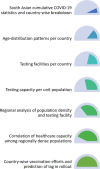An epidemiological, strategic and response analysis of the COVID-19 pandemic in South Asia: a population-based observational study
- PMID: 35255848
- PMCID: PMC8900114
- DOI: 10.1186/s12889-022-12811-y
An epidemiological, strategic and response analysis of the COVID-19 pandemic in South Asia: a population-based observational study
Abstract
Introduction: South Asia has had a dynamic response to the ongoing COVID-19 pandemic. The overall burden and response have remained comparable across highly-burdened countries within the South Asian Region.
Methodology: Using a population-based observational design, all eight South Asian countries were analyzed using a step-wise approach. Data were obtained from government websites and publicly-available repositories for population dynamics and key variables.
Results: South Asian countries have a younger average age of their population. Inequitable distribution of resources centered in urban metropolitan cities within South Asia is present. Certain densely populated regions in these countries have better testing and healthcare facilities that correlate with lower COVID-19 incidence per million populations. Trends of urban-rural disparities are unclear given the lack of clear reporting of the gaps within these regions. COVID-19 vaccination lag has become apparent in South Asian countries, with the expected time to complete the campaign being unfeasible as the COVID-19 pandemic progresses.
Conclusion: With a redesigning of governance policies on preventing the rise of COVID-19 promptly, the relief on the healthcare system and healthcare workers will allow for adequate time to roll out vaccination campaigns with equitable distribution. Capacity expansion of public health within the Region is required to ensure a robust healthcare response to the ongoing pandemic and future infectious disease outbreaks.
Keywords: Age; COVID-19; Case-fatality Ratio; Rural; South Asia; Testing; Urban; Vaccine.
© 2022. The Author(s).
Conflict of interest statement
The authors declare that the research was conducted in the absence of any commercial or financial relationships that could be construed as a potential conflict of interest.
Figures




References
-
- WHO Coronavirus Disease (COVID-19) Dashboard.
-
- Bank TW . Population, total - South Asia. 2021.
-
- Paul A, Chatterjee S, Bairagi N. Prediction on Covid-19 epidemic for different countries: Focusing on South Asia under various precautionary measures. medRxiv. 2020; March.
-
- Islam MM, Jannat A, Al Rafi DA, Aruga K. Potential Economic Impacts of the COVID-19 Pandemic on South Asian Economies: A Review. 2020. pp. 283–299.
-
- Yadav A, Iqbal BA. Socio-economic Scenario of South Asia: An Overview of Impacts of COVID-19. South Asian Surv. 2021;28:20–37. doi: 10.1177/0971523121994441. - DOI
Publication types
MeSH terms
Substances
LinkOut - more resources
Full Text Sources
Medical

